Dekolink Wireless CBDATDMAB1W60 MW-CBDA-TDMAB-1W60-A Cellular Bi-Directional Amplier User Manual Installation and operating instructions
Dekolink Wireless Ltd MW-CBDA-TDMAB-1W60-A Cellular Bi-Directional Amplier Installation and operating instructions
Installation and operating instructions
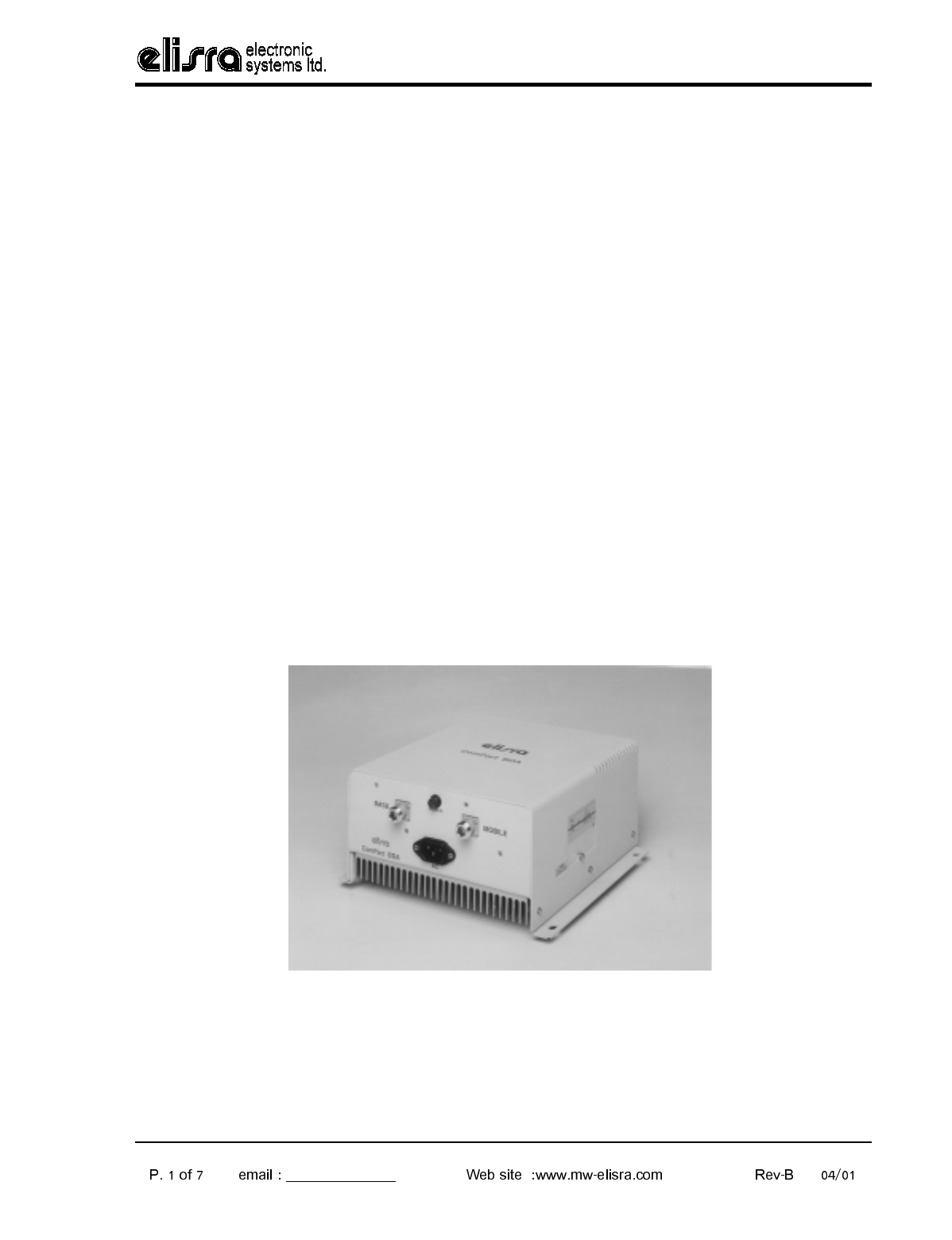
Wireless Solutions
48 Mivtza Kadesh St. Bene Beraq 51203 , ISRAEL Tel: +972-3-6175639 Fax:+972-3-6175962
trm1@elisra.com
INSTALLATION
AND
OPERATING INSTRUCTIONS
FOR
MW-CBDA-TDMAB-1W60-A
CELLULAR
BI-DIRECTIONAL AMPLIFIER

Wireless Solutions
48 Mivtza Kadesh St. Bene Beraq 51203 , ISRAEL Tel: +972-3-6175639 Fax:+972-3-6175962
trm1@elisra.com
TABLE OF CONTENTS
PARAGRAPH PAGE No
BDA OVERVIEW 3
BLOCK DAIGRAM DESCRIPTION 3
BDA OPERATION 4
AGC & MGC FUNCTION 5
RF EXPOSURE WARNING 6
ELECTRICAL SPECIFICATIONS 7
MECHANICAL SPECIFICATIONS 7
ENVIRONMENTAL CONDITIONS 7
LIST OF DRAWINGS
DRAWING PAGE No
BDA (WITH AGC) RF BLOCK DIAGRAM DRAWING 4
AGC & MGC CONTROL 5
MECHANICAL OUTLINE 8

Wireless Solutions
48 Mivtza Kadesh St. Bene Beraq 51203 , ISRAEL Tel: +972-3-6175639 Fax:+972-3-6175962
trm1@elisra.com
BDA OVERVIEW:
The Bi-Directional Amplifier (BDA) assembly provides an exceptional repeater/booster performances to
extend the coverage area of radio communications in buildings and RF shielded environments.
Features such as high linearity power amplifiers are contributing for the overall improved system linearity
performances. The unit is based on a duplexed path configuration, having sharp out of band attenuation
for improved isolation between the receiving and transmitting paths.
BLOCK DIAGRAM DESCRIPTION:
The CBDA Downlink path receives the RF signals from base station amplifies them and transmits them
to the subscriber. The BDA Uplink path receives the RF signals from the subscriber amplifies them and
transmits them to the base station. Two duplexers frequency separate the signals to the proper
amplifying path and isolate the two signals.
For each path there is an AGC amplifier. The amplifier has an AGC option switch. When switched on,
the AGC circuit limits the amplifier output power. The AGC circuit senses the output power and
introduces more attenuation, when the output power exceeds the preset level. This way the gain of the
amplifier is reduced, its output power is limited and the intermodulations products are kept below the
desired level.
In this manner the output power cannot exceed the +24 dBm preset power and the IMD levels are
13 dBm.
The AGC amplifier has a Power LED lamp that illuminates when the output power has reached the
preset power limit.
In addition the BDA has a trimmer that enables continuos reduction of the gain by 15 dB.
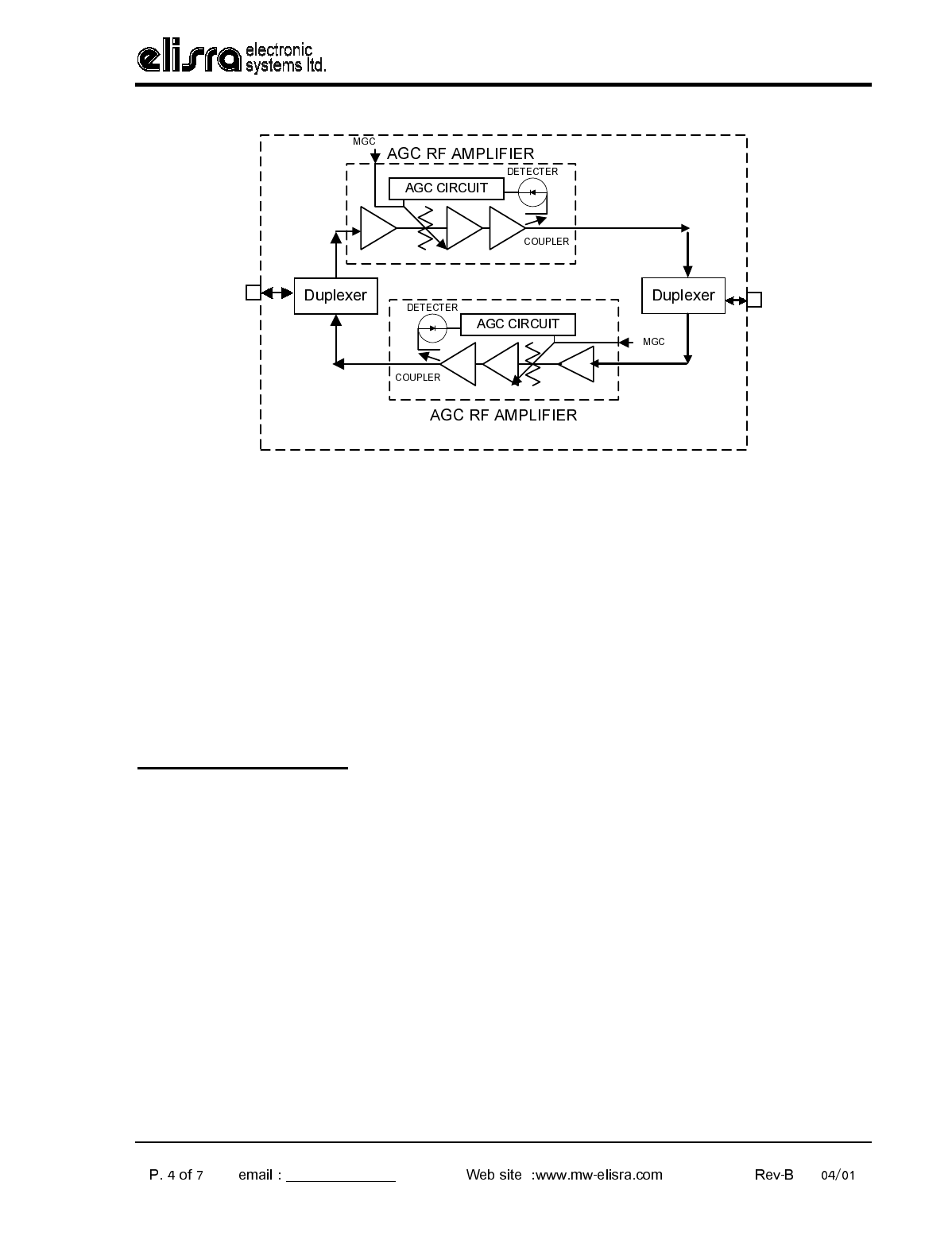
Wireless Solutions
48 Mivtza Kadesh St. Bene Beraq 51203 , ISRAEL Tel: +972-3-6175639 Fax:+972-3-6175962
trm1@elisra.com
BDA with AGC & MGC
DETAILED RF BLOCK DIAGRAM
BDA OPERATION
connected to the antenna pointing into the area to be covered by the BDA.
The isolation between the base station antenna and the mobile antenna should be at least 12 dB higher
than the BDA gain. If the isolation were less than the BDA gain, oscillation would start and would
saturate the amplifier. Isolation few dB higher than the BDA gain cannot start oscillations but would
causes gain ripple in the band.
'RZQOLQN
8SOLQN
72
%$6(
67$7,21
$17(11$
72
$5($
$17(11$
17<3(
17<3(
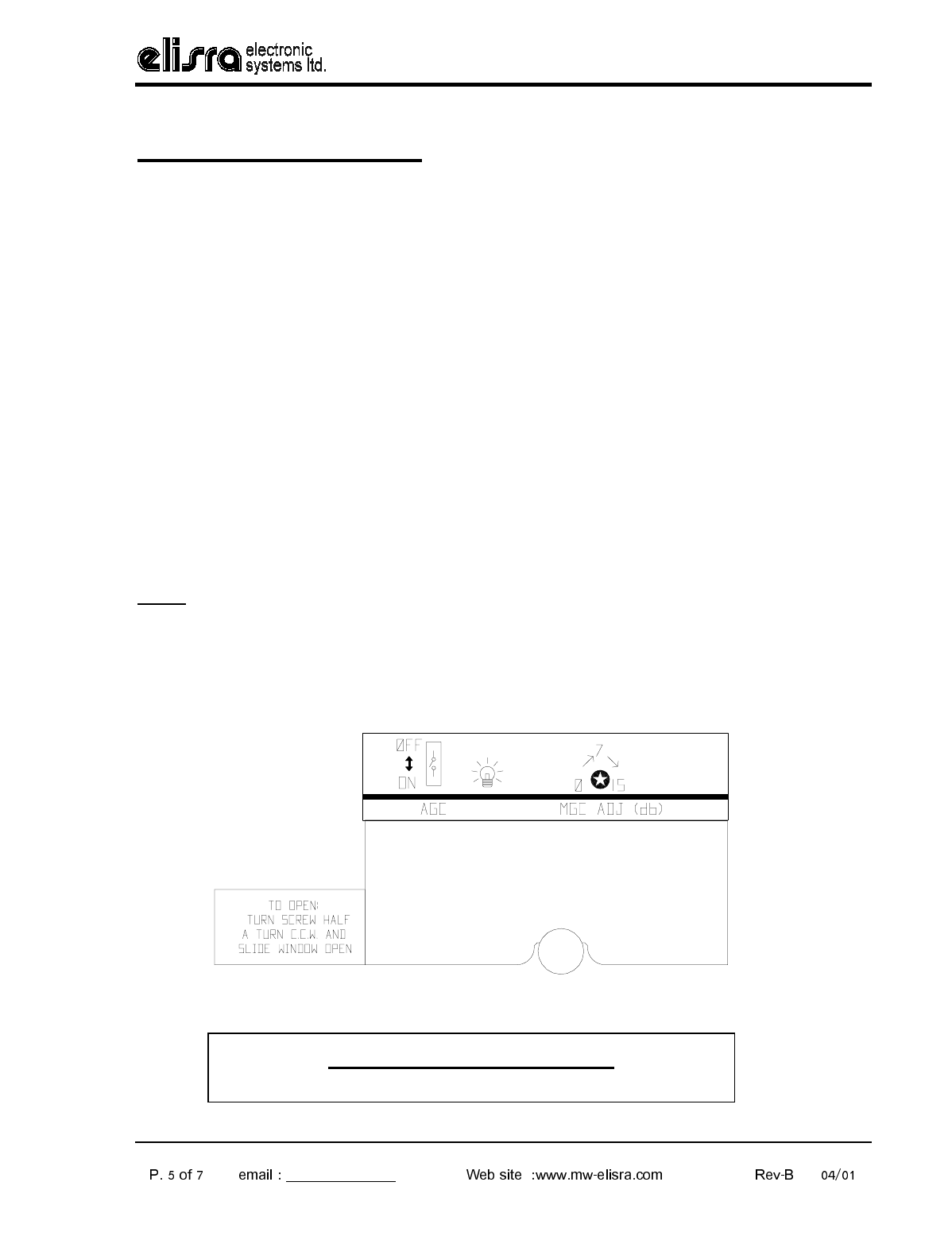
Wireless Solutions
48 Mivtza Kadesh St. Bene Beraq 51203 , ISRAEL Tel: +972-3-6175639 Fax:+972-3-6175962
trm1@elisra.com
AGC & MGC FUNCTION
The BDA has AGC function. Their amplifier has a directional coupler and a detector at the output of the
high power amplifier to monitor the output power. When a high signal is received the automatic level
control detects the amplitude and sends a feedback signal to a voltage variable attenuator which
attenuates the signal level so that the output power of the amplifier does not exceed the preset limit. The
LED on the amplifier illuminates when the power out the amplifier is within the set limit (both when the
AGC is On and when the AGC is OFF).
The switch on the RF amplifier enables the AGC function. If the AGC is disabled then the amplifier gives
maximum gain.
MGC: The RF gain of the BDA can be reduced by about 15 dB using the continuos trimmer on the
amplifier. The RF gain is at maximum when the trimmer is at anti-clockwise direction. To reduce the
gain, turn the trimmer clockwise using a screwdriver. Turning it halfway would reduce the gain by 7.5 dB.
The AGC and MGC functions for the uplink path are reached by opening a small cover located on the
DBA side adjacent to the Mobile antenna port. For the downlink path the window is located on the side
near the Base antenna port.
Note: The BDA is shipped with the AGC switch in the OFF position and maximum RF gain.
AGC
Enable
Switch
Power
Out
LED
G
ain Control
Trimmer
(MGC)
AGC & MGC CONTROL
(Control Window Located at BDA sides)

Wireless Solutions
48 Mivtza Kadesh St. Bene Beraq 51203 , ISRAEL Tel: +972-3-6175639 Fax:+972-3-6175962
trm1@elisra.com
RF EXPOSURE WARNING
In order to satisfy the FCC RF exposure requirements, you must ensure that the
installation complies with the following:
One antenna is connected via cable that has typical 1~10 dB attenuation (depends on
the length of the cable) to the BDA BASE port. This antenna is installed outdoor and
has very sharp beam (Yagi type or similar) pointed to the donor (BTS). This type of
antenna has about 10 dBi gain. Typical specifications: gain: 8 dBd (=10.1 dBi),
VSWR: better than 1.5:1 , Impedance: 50 ohm. The outdoor antenna must be installed
to provide a minimum separation distance of 0.3 m (30 cm) from persons within the
area.
The second antenna is connected via cable that has typical 1~10 dB attenuation
(depends on the length of the cable) to the CBDA MOBILE port. This type of antenna
is omnidirecttional (isotropic), or wide beam, with 0 to 2 dBi typical gain and is installed
and distributes indoor (in buildings, tunnels, basements, park lots, shopping centers
etc.). Typical specifications: gain: 2 dBi, VSWR: better than 2:1 , Impedance: 50 ohm.
The indoor antenna must be installed to provide a minimum separation distance of
0.2 m (20 cm) from persons within the area.
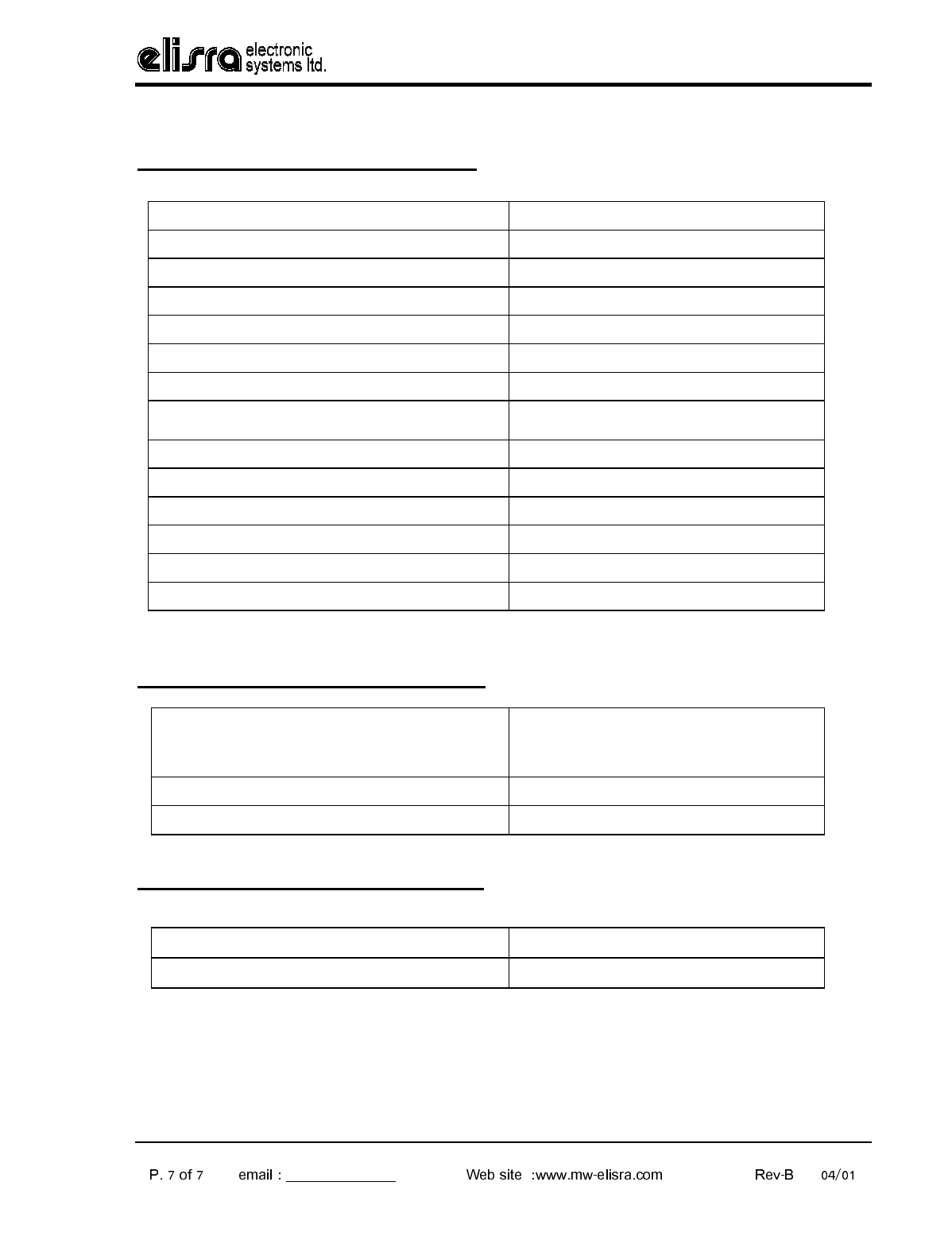
Wireless Solutions
48 Mivtza Kadesh St. Bene Beraq 51203 , ISRAEL Tel: +972-3-6175639 Fax:+972-3-6175962
trm1@elisra.com
ELECTRICAL SPECIFICATIONS:
Frequency Range Up Link : 835 849 MHz
Down Link : 880 894 MHz
Passband Gain @ min attenuation 60 dB minimum
Passband Ripple 1.5 dB typical
Output Power AGC Set +24 1 dBm
AGC Dynamic Range 30 dB min
MGC (Manual Gain Control) Dynamic Range 15 dB min
Noise Figure @+25 C at max gain 6.0 dB max
3rd Order Intercept point +45 dBm typical
IMD @2 tone @+20 dBm/carrier 50 dBc typical
Isolation between Up/Down Link 75 dB min
Impedance Level 50 Ohms
VSWR 1.5 : 1 max
Power Supply 80 to 240 VAC; 50 to 60 Hz; @500 mA
MECHANICAL SPECIFICATIONS:
Size : 10 x 10 x 5 inch approx.
(250 x 250 x 120 mm approx.)
RF Connectors : N-type Female
Weight : 15 Lbs. (7 kg.) approx.
ENVIRONMENTAL CONDITIONS:
The unit is designed for indoor applications:
Operating temperature : - 30 C to + 50 C
Storage temperature : - 50 C to + 80 C
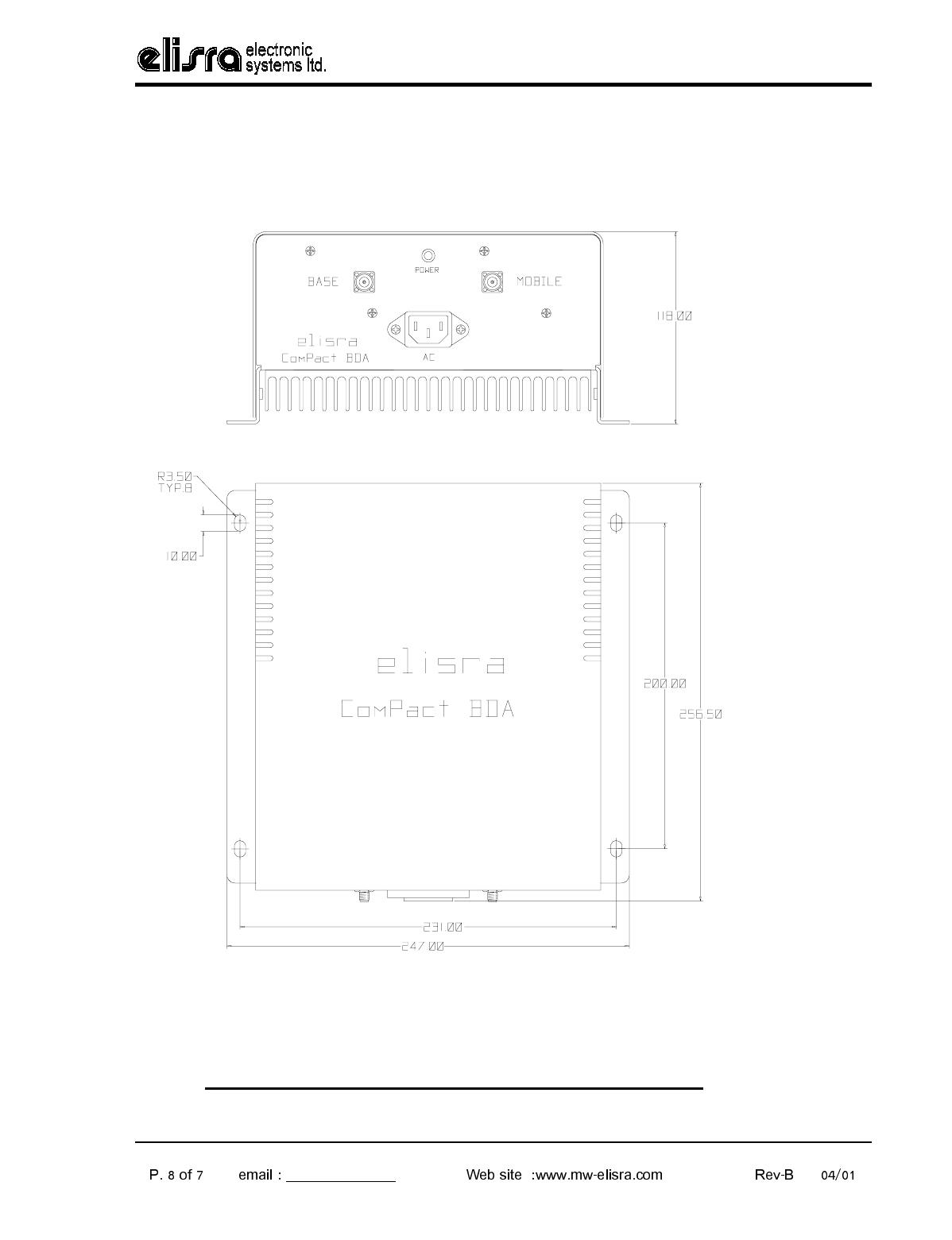
Wireless Solutions
48 Mivtza Kadesh St. Bene Beraq 51203 , ISRAEL Tel: +972-3-6175639 Fax:+972-3-6175962
trm1@elisra.com
MECHANICAL OUTLINE